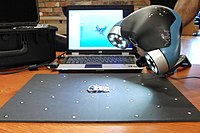
Photo from wikipedia
In restorative dentistry, the in situ replication of intra-oral situations, is based on a non-invasive and non-destructive scanning electron microscopy (SEM) evaluation method. The technique is suitable for investigation restorative… Click to show full abstract
In restorative dentistry, the in situ replication of intra-oral situations, is based on a non-invasive and non-destructive scanning electron microscopy (SEM) evaluation method. The technique is suitable for investigation restorative materials and dental hard- and soft-tissues, and its interfaces. Surface characteristics, integrity of interfaces (margins), or fracture analysis (chipping, cracks, etc.) with reliable resolution and under high magnification (from ×50 to ×5,000). Overall the current study aims to share detailed and reproducible information about the replica technique. Specific goals are: (a) to describe detailed each step involved in producing a replica of an intra-oral situation, (b) to validate an integrated workflow based on a rational sequence from visual examination, to macrophotography and SEM analysis using the replica technique; (c) to present three clinical cases documented using the technique. A compilation of three clinical situations/cases were analyzed here by means the replica technique showing a wide range of possibilities that can be reached and explored with the described technique. This guidance document will contribute to a more accurate use of the replica technique and help researchers and clinicians to understand and identify issues related to restorative procedures under high magnification.
Journal Title: Microscopy research and technique
Year Published: 2020
Link to full text (if available)
Share on Social Media: Sign Up to like & get
recommendations!